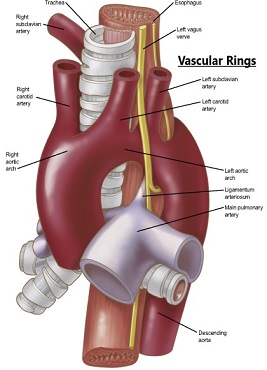Index
Vascular Rings

What Is Vascular Rings?
A vascular ring is a congenital defect in which there is an abnormal formation of the aorta and/or its surrounding blood vessels.
The trachea and esophagus are completely encircled and sometimes compressed by a "ring" formed by these vessels, which can lead to breathing
and digestive difficulties.
Most often this is because of persistence of the double aortic arch after the second month of fetal life.
Another definition of vascular ring is a type of congenital lesion where normal vessels are in an abnormal location and may cause
compression or obstruction of the esophagus or airway. These arteries may be those carrying blood to the body, to the lungs, or both.
What Causes Vascular Rings?
Normally, the aorta develops from one in a series of symmetrical arches. By the end of the second month of fetal development,
the other arches are naturally broken down or formed into arteries. When a vascular ring occurs, certain arches that should have disappeared
still remain and form a ring structure.

What are the Signs & Symptoms of Vascular Rings?
Symptoms range widely depending on the severity of the compression and can include:
- Stridor (Noisy Breathing)
- Wheezing or Cough
- Respiratory Distress
- Respiratory Infections
Other Symptons can be:
- Gastroesophageal Reflux (GERD)
- Swallowing difficulties (Dysphagia)
- Difficulty Feeding (when you introduce solid foods).
- Stridor (Noisy Breathing)
- Wheezing or Cough
- Respiratory Distress
- Respiratory Infections
Other Symptons can be:
- Gastroesophageal Reflux (GERD)
- Swallowing difficulties (Dysphagia)
- Difficulty Feeding (when you introduce solid foods).
HEART CONDITIONS Diseases and Treated FAQ's
Infants with vascular rings typically present before 12 months with respiratory or esophageal
symptoms like stridor, wheezing, cough, dysphagia, or difficulty feeding. The stridor improves with neck extension,
differentiating from laryngomalacia which is relieved by prone or upright positioning, and will not be relieved
with corticosteroids or epinephrine, unlike croup. Diagnosis requires a high degree of clinical suspicion and
can be confirmed with barium contrast esophagogram for those with esophageal symptoms, bronchoscopy, or CT or MRI.
It is sometimes treated with surgery.
Surgeons divide the vascular rings to release the circles pressing against the trachea and esophagus.
The procedure is often conducted during open surgery, but in some cases a minimally invasive approach may be used.
Multiple specialists, including congenital cardiologists, doctors trained in lung conditions (pulmonologists), doctors trained in digestive conditions (gastroenterologists), and doctors trained in ear, nose and throat conditions may be involved in their care.
Surgeons divide the vascular rings to release the circles pressing against the trachea and esophagus.
The procedure is often conducted during open surgery, but in some cases a minimally invasive approach may be used.
Multiple specialists, including congenital cardiologists, doctors trained in lung conditions (pulmonologists), doctors trained in digestive conditions (gastroenterologists), and doctors trained in ear, nose and throat conditions may be involved in their care.
Advertisement. Vascular rings that press against the trachea and esophagus can lead to breathing and digestive problems.
Respiratory signs and symptoms may include frequent respiratory infections, wheezing or coughing.
Digestive signs and symptoms may include trouble swallowing, difficulty feeding or vomiting.
Some of the risks include injury to the nerves that control the vocal cords (voice box).
These nerves are specifically looked for during surgery but may have to be moved a bit in order to take care of the vascular ring.
This can cause a soft voice or cry in babies after surgery but this will get better in several weeks, if it happens.
Another possible problem is a lymph leak in the chest after surgery. This is due to drainage of clear fluid from lymphatic ducts in the chest.
While this is not common, it can be a difficult problem to take care of and involve dietary measures, medicine or even further surgery.
Respiratory signs and symptoms may include frequent respiratory infections, wheezing or coughing.
Digestive signs and symptoms may include trouble swallowing, difficulty feeding or vomiting.
Some of the risks include injury to the nerves that control the vocal cords (voice box).
These nerves are specifically looked for during surgery but may have to be moved a bit in order to take care of the vascular ring.
This can cause a soft voice or cry in babies after surgery but this will get better in several weeks, if it happens.
Another possible problem is a lymph leak in the chest after surgery. This is due to drainage of clear fluid from lymphatic ducts in the chest.
While this is not common, it can be a difficult problem to take care of and involve dietary measures, medicine or even further surgery.